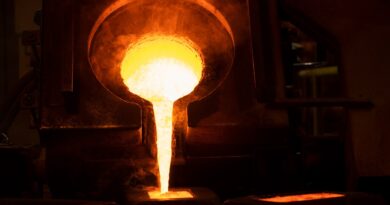South Africa’s platinum output rose by 7% year-on-year
Refined mine supply experienced a 4% year-on-year increase to 1,540 koz, due to growth from South Africa, which offset declines from other regions. South Africa’s output rose by 7% year-on-year to 1,126 koz, underpinned by higher refining volumes from Anglo American Platinum (Amplats) and Impala Platinum (Implats).
Amplats’ production benefited from the processing of semi-finished inventory, with refined output surpassing underlying mine production. As part of its cost-saving initiatives, Amplats placed its Mortimer smelter on care and maintenance in April, leaving three smelters in operation. However, the company anticipates that the reconfiguration of its processing operations will have minimal impact on overall production.
Implats’ output was affected by the scheduled rebuild of Furnace No. 5 at the Impala Rustenburg facility, which was recommissioned in April. However, the absence of load curtailment, which had impacted Q2’23, resulted in an increase in output.
Zimbabwe’s output remained stable year-on-year at 125 koz, as a decline at Zimplats was offset by growth at Unki. In Russia, production fell by 5% year-on-year to 181 koz, primarily due to lower platinum content in Nornickel’s PGM ore sources. The company is currently undertaking maintenance on Furnace # 2 at the Nadezhda Metallurgical Plant, with the impact on platinum production expected to be reflected in the second half of the year.
North American production declined by 17% year-on-year to 61 koz. This was primarily due to reduced output from Vale’s by-product nickel mining, which in turn stemmed from planned maintenance of processing infrastructure.
Sibanye-Stillwater announced on 11th July that a cyber-attack had impacted its global IT systems, delaying the release of operating results. While some disruption to US PGM operations was reported, the full impact on production volumes remains undetermined.
Recycling
During Q2’24, global recycling remained broadly steady compared to Q2’23, rising by just 1% year-on-year (+4 koz). This was driven by a slight increase in spent autocatalyst recycling, which helped offset declines in both jewellery and electronic scrap. With stable-to-marginal gains in collections across most regions and a gradual return to pre-government intervention levels in China, Q2’24 saw platinum supply from end-of-life vehicles increase by 2% year-on-year (+7 koz).
In the US, high interest rates have encouraged consumers to hold on to their vehicles for longer, limiting the flow of older cars to scrapyards. Additionally, a cyber-attack on widely used sales and inventory management software in the US in June further disrupted the vehicle pipeline, affecting both new andused car sales.
The jewellery segment experienced a 5% decline in supply during Q2’24 (-4 koz), primarily due to reduced reselling activity in Japan. In contrast, Chinese platinum jewellery scrap remained stable year-on-year in Q2’24 although it was significantly lower than in Q1’24, when platinum was scrapped to release cash to bolster gold jewellery stocks during the Chinese New Year.
Despite continued price weakness, an increase in product exchange activities (where heavier jewellery pieces are sold back in exchange for lighter, premium designs) provided some support to scrap levels. In the industrial waste segment, due to the upgrade of storage facilities by data centres in response to demands created by large language models (LLM), the recovery of platinum from hard disk drives and host equipment has increased.




